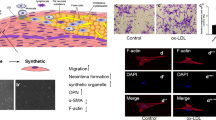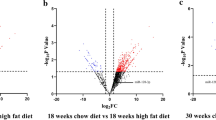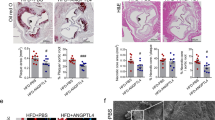Abstract
Fetuin-B is a serum protein linked to the regulation of physiological or pathophysiological events such as fertility, energy metabolism, and liver disease. Recently, fetuin-B has been reported to be involved in the modulation of the rupture of atherosclerotic plaques associated with acute myocardial infarction. However, the exact mechanism involved in the modulation of atherosclerotic plaque rupture event by fetuin-B is not fully elucidated yet. In the present study, we investigated whether fetuin-B could influence atherosclerotic plaque rupture through vascular smooth muscle cells (VSMCs). Immunoprecipitation assay using membrane proteins from VSMCs revealed that fetuin-B tightly bound to transforming growth factor-β receptor (TGF-βR). Fetuin-B treatment elevated TGF-βR signals (e.g., phosphorylation of Smad2 and Smad3) in VSMCs. Fetuin-B also stimulated nuclear translocation of phosphorylated Smads. Phosphorylation of Smad and its nuclear translocation by treatment with fetuin-B were inhibited in VSMCs by treatment with SB431542, a selective inhibitor of TGF-βR. Fetuin-B enhanced expression levels of plasminogen activator inhibitor-1 (PAI-1) and matrix metalloproteinase-2 (MMP-2) in VSMCs through its epigenetic modification including recruitments of both histone deacetylase 1 and RNA polymerase II. These epigenetic alterations in VSMCs were also inhibited by treatment with SB431542. In vivo administration of fetuin-B protein increased expression levels of PAI-1 and MMP-2 in the vascular plaque. However, these increases in expression were inhibited by the administration of SB43154. These results indicate that fetuin-B may modulate vascular plaque rupture by promoting expression of PAI-1 and MMP-2 in VSMCs via TGF-βR-mediated Smad pathway.






Similar content being viewed by others
References
Afsar CU, Uzun H, Yurdakul S, Muderrisoglu C, Ergüney M, Demir B, Aslan A, Aral H, Ozyazgan S (2012) Association of serum fetuin-A levels with heart valve calcification and other biomarkers of inflammation among persons with acute coronary syndrome. Clin Invest Med 35:E206–E215
Basar N, Sen N, Kanat S, Ozlu MF, Ozcan F, Cay S, Erden G, Cagli KE, Yildirimkaya M, Maden O, Covic A, Kanbay M (2011) Lower fetuin-A predicts angiographic impaired reperfusion and mortality in ST-elevation myocardial infarction. Investig Med 59:816–822
Braganza DM, Bennett MR (2001) New insights into atherosclerotic plaque rupture. Postgrad Med J 77:94–98
Chen F, Eriksson P, Hansson GK, Herzfeld I, Klein M, Hansson LO, Valen G (2005) Expression of matrix metalloproteinase 9 and its regulators in the unstable coronary atherosclerotic plaque. Int J Mol Med 15:57–65
Chen YG, Meng AM (2004) Negative regulation of TGF-β signaling in development. Cell Res 14:441–449
Demetriou M, Binkert C, Sukhu B, Tenenbaum HC, Dennis JW (1996) Fetuin/alpha2-HS glycoprotein is a transforming growth factor-β type II receptor mimic and cytokine antagonist. J Biol Chem 271:12755–12761
Denecke B, Gräber S, Schäfer C, Heiss A, Wöltje M, Jahnen-Dechent W (2003) Tissue distribution and activity testing suggest a similar but not identical function of fetuin-B and fetuin-A. Biochem J 376:135–145
Dhawan S, Dirice E, Kulkarni RN, Bhushan A (2016) Inhibition of TGF-β signaling promotes human pancreatic β-cell replication. Diabetes 65:1208–1218
Falk E, Shah PK, Fuster V (1995) Coronary plaque disruption. Circulation 92:657–671
Fishbein MC (2010) The vulnerable and unstable atherosclerotic plaque. Cardiovasc Pathol 19:6–11
Galis ZS, Sukhova GK, Lark MW, Libby P (1994) Increased expression of matrix metalloproteinases and matrix degrading activity in vulnerable regions of human atherosclerotic plaques. J Clin Invest 94:2493–2503
Grønholdt ML, Dalager-Pedersen S, Falk E (1998) Coronary atherosclerosis: determinants of plaque rupture. Eur Heart J 19(Suppl C):C24–C29
Heldin CH, Miyazono K, ten Dijke P (1997) TGF-β signaling from cell membrane to nucleus through SMAD proteins. Nature 390:465–471
Hojo Y, Ikeda U, Ta K, Mizuno O, Fujikawa H, Shimada K (2002) Matrix metalloproteinase expression in the coronary circulation induced by coronary angioplasty. Atherosclerosis 161:185–192
Hsu SJ, Nagase H, Balmain A (2004) Identification of Fetuin-B as a member of a cystatin-like gene family on mouse chromosome 16 with tumor suppressor activity. Genome 47:931–946
Jahnen-Dechent W, Schinke T, Trindl A, Müller-Esterl W, Sablitzky F, Kaiser S, Blessing M (1997) Cloning and targeted deletion of the mouse fetuin gene. J Biol Chem 272:31496–31503
Jung SH, Won KJ, Lee KP, Kim HJ, Seo EH, Lee HM, Park ES, Lee SH, Kim B (2015) The serum protein fetuin-B is involved in the development of acute myocardial infarction. Clin Sci (Lond) 129:27–38
Lee C, Bongcam-Rudloff E, Sollner C, Jahnen-Dechent W, Claesson-Welsh L (2009) Type 3 cystatins; fetuins, kininogen and histidine-rich glycoprotein. Front Biosci (Landmark Ed) 14:2911–2922
Lee DY, Kim HS, Won KJ, Lee KP, Jung SH, Park ES, Choi WS, Lee HM, Kim B (2015) DJ-1 regulates the expression of renal (pro)renin receptor via reactive oxygen species-mediated epigenetic modification. Biochim Biophys Acta 1850:426–434
Lee KP, Baek S, Jung SH, Cui L, Lee D, Lee DY, Choi WS, Chung HW, Lee BH, Kim B, Won KJ (2018) DJ-1 is involved in epigenetic control of sphingosine-1-phosphate receptor expression in vascular neointima formation. Pflugers Arch 470:1103–1113
Li Z, Li L, Zielke HR, Cheng L, Xiao R, Crow MT, Stetler-Stevenson WG, Froehlich J, Lakatta EG (1996) Increased expression of 72-kd type IV collagenase (MMP-2) in human aortic atherosclerotic lesions. Am J Pathol 148:121–128
Lijnen HR (2001) Elements of the fibrinolytic system. Ann N Y Acad Sci 936:226–236
Lim P, Moutereau S, Simon T, Gallet R, Probst V, Ferrieres J, Gueret P, Danchin N (2013) Usefulness of fetuin-A and C-reactive protein concentrations for prediction of outcome in acute coronary syndromes (from the French Registry of Acute ST-Elevation Non-ST-Elevation Myocardial Infarction [FAST-MI]). Am J Cardiol 111:31–37
Livak KJ, Schmittgen TD (2001) Analysis of relative gene expression data using real-time quantitative PCR and the 2−ΔΔCT method. Methods 25:402–408
Lu P, Takai K, Weaver VM, Werb Z (2011) Extracellular matrix degradation and remodeling in development and disease. Cold Spring Harb Perspect Biol 3:a005058
Meex RC, Hoy AJ, Morris A, Brown RD, Lo JC, Burke M, Goode RJ, Kingwell BA, Kraakman MJ, Febbraio MA, Greve JW, Rensen SS, Molloy MP, Lancaster GI, Bruce CR, Watt MJ (2015) Fetuin B is a secreted hepatocyte factor linking steatosis to impaired glucose metabolism. Cell Metab 22:1078–1089
Murakami T, Walczak R, Caron S, Duhem C, Vidal V, Darteil R, Staels B (2007) The farnesoid X receptor induces fetuin-B gene expression in human hepatocytes. Biochem J 407:461–469
Nadkarni SK, Bouma BE, de Boer J, Tearney GJ (2009) Evaluation of collagen in atherosclerotic plaques: the use of two coherent laser-based imaging methods. Lasers Med Sci 24:439–445
Newby AC, Zaltsman AB (1999) Fibrous cap formation or destruction--the critical importance of vascular smooth muscle cell proliferation, migration and matrix formation. Cardiovasc Res 41:345–360
Pandolfi A, Cetrullo D, Polishuck R, Alberta MM, Calafiore A, Pellegrini G, Vitacolonna E, Capani F, Consoli A (2001) Plasminogen activator inhibitor type 1 is increased in the arterial wall of type II diabetic subjects. Arterioscler Thromb Vasc Biol 21:1378–1382
Ploplis VA (2011) Effects of altered plasminogen activator inhibitor-1 expression on cardiovascular disease. Curr. Drug Targets 12:1782–1789
Santibañez JF, Quintanilla M, Bernabeu C (2011) TGF-β/TGF-β receptor system and its role in physiological and pathological conditions. Clin Sci (Lond) 121:233–251
Shah PK (2002) Pathophysiology of coronary thrombosis: role of plaque rupture and plaque erosion. Prog Cardiovasc Dis 44:357–368
Shah PK, Galis ZS (2001) Matrix metalloproteinase hypothesis of plaque rupture: players keep piling up but questions remain. Circulation 104:1878–1880
Shi Y, Massagué J (2003) Mechanisms of TGF-β signaling from cell membrane to the nucleus. Cell 113:685–700
Suwanabol PA, Seedial SM, Zhang F, Shi X, Si Y, Liu B, Kent KC (2012) TGF-β and Smad3 modulate PI3K/Akt signaling pathway in vascular smooth muscle cells. Am J Physiol Heart Circ Physiol 302:H2211–H2219
Swedenborg J, Eriksson P (2006) The intraluminal thrombus as a source of proteolytic activity. Ann N Y Acad Sci 1085:133–138
Volcik KA, Campbell S, Chambless LE, Coresh J, Folsom AR, Mosley TH, Ni H, Wagenknecht LE, Wasserman BA, Boerwinkle E (2010) MMP2 genetic variation is associated with measures of fibrous cap thickness: the atherosclerosis risk in communities carotid MRI study. Atherosclerosis 210:188–193
Wang J, Uryga AK, Reinhold J, Figg N, Baker L, Finigan A, Gray K, Kumar S, Clarke M, Bennett M (2015) Vascular smooth muscle cell senescence promotes atherosclerosis and features of plaque vulnerability. Circulation 132:1909–1919
Weikert C, Stefan N, Schulze MB, Pischon T, Berger K, Joost HG, Häring HU, Boeing H, Fritsche A (2008) Plasma fetuin-a levels and the risk of myocardial infarction and ischemic stroke. Circulation 118:2555–2562
Wu ML, Chen CH, Lin YT, Jheng YJ, Ho YC, Yang LT, Chen L, Layne MD, Yet SF (2014) Divergent signaling pathways cooperatively regulate TGFβ induction of cysteine-rich protein 2 in vascular smooth muscle cells. Cell Commun Signal 12:22
Funding
This research was supported by Basic Science Research Program through the National Research Foundation of Korea (NRF) funded by the Korean government (NRF-2016R1D1A1B03934204; 2017R1D1A1B03035674). It was also supported by a grant of the Korea Health Technology R&D Project through the Korea Health Industry Development Institute (KHIDI), funded by the Ministry of Health & Welfare, Republic of Korea (HI15C1540).
Author information
Authors and Affiliations
Contributions
S.H.J. and K.-J.W. conceived and designed the study. S.H.J., D.L., H.J., K.J.L., S.J.K., and Y.R. performed experiments and data acquisition. S.H.J., D.L., and H.J. prepared the figures. S.H.J., D.L., H.M.L., H.M.K., W.S.C., and K.-J.W. analyzed and interpreted the data. S.H.L., B.K., and K.-J.W. drafted and revised manuscript. All authors have read and approved the final manuscript.
Corresponding author
Ethics declarations
All animal procedures in this study were in strict adherence to the Guide for the Care and Use of Laboratory Animals as adopted by the U.S. National Institutes of Health (NIH publication No. 85-23, revised 1996) and were approved by the Animal Subjects Committee and by the Institutional Guidelines of Konkuk University, South Korea.
Conflict of interest
The authors declare that there are no competing interests.
Additional information
Publisher’s note
Springer Nature remains neutral with regard to jurisdictional claims in published maps and institutional affiliations.
Electronic supplementary material
ESM 1
(PDF 182 kb).
Rights and permissions
About this article
Cite this article
Jung, S.H., Lee, D., Jin, H. et al. Fetuin-B regulates vascular plaque rupture via TGF-β receptor-mediated Smad pathway in vascular smooth muscle cells. Pflugers Arch - Eur J Physiol 472, 571–581 (2020). https://doi.org/10.1007/s00424-020-02385-2
Received:
Revised:
Accepted:
Published:
Issue Date:
DOI: https://doi.org/10.1007/s00424-020-02385-2




